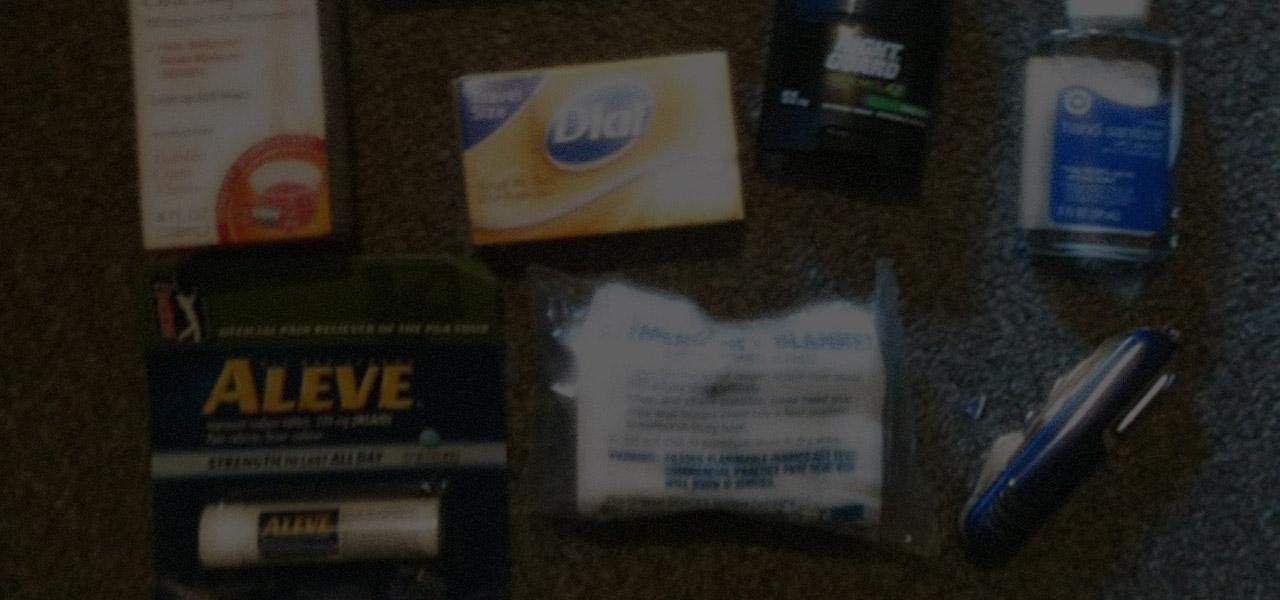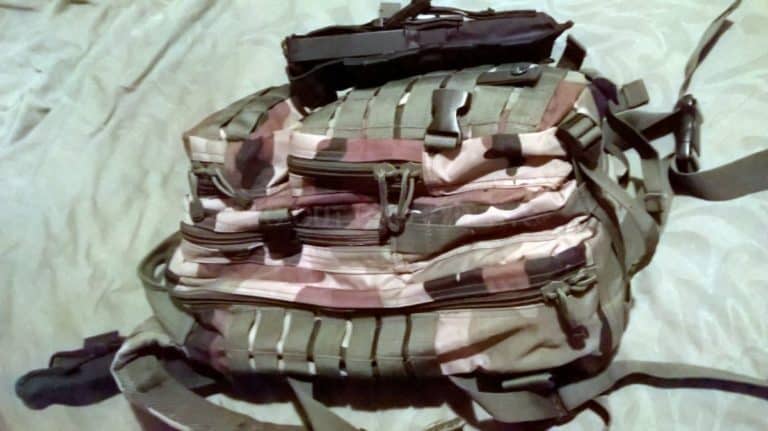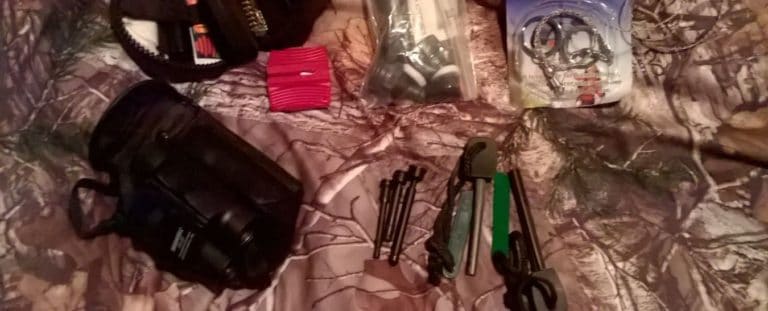Get Home Bag – The Ultimate List of Survival Items
Preppers and survivalists are obsessed with bags: bags for bugging out, bags for bugging in, 72 hour bags, INCH bags and even car BOBs, all well prepared and ready for impending disaster or emergency.
Realistically though, there is one bag that is going to be used more than any other, and it will be used far more often than all your other preps, that’s the get home bag. Forget bugging out and never coming home, what if disaster strikes while you are at work or away from home and you need to get home to your family before taking any other action what do you have on you right now to make that possible?
It doesn’t even need to be a major national emergency or natural disaster that threatens your commute home, although it might. Public transport strikes, flooded roads, fuel shortages and severe seasonal weather such as heavy snow might all prevent you from getting home.
So what are you going to do about it? What do you have in place to make sure you can make it home to your family and take charge in the event of an emergency or even just in case of more mundane obstacles?
Your get home bag should help in this regard and just as with any other survival kit it will need to be customized to your specific requirements, distance from home, intended mode of transport, local laws and many other factors.
So what should you definitely carry regardless of any specific kit related to your mode of transport;
THE GET HOME BAG ITEMS LIST
- Spare battery and charging cable for cell phone, even if you shouldn’t count on your phone and other technology in an emergency you should do what you can to keep your phone functioning.
- Emergency contact details; now that people tend to rely on their cell phones to remember numbers for them make sure you write down essential contact details and keep them in your get home bag, even if you do remember all the important numbers you need write them down anyway as stressful situations can make you forget things. You will want to have family members’ numbers and those of your kids’ school at hand. Maybe your get home ‘emergency’ is that you are going to be late to pick your children up because your car has broken down or you have been held up because of roadworks or an accident or a family emergency, having the school’s number to hand will be important.
- Local map.
- Cash (at least enough for a night’s accommodation, a train ticket or to pay for a tow truck) some should be in change.
- Vital documents (you may well carry these in your wallet or purse but copies in your get home bag are important too, in case of national emergency you may need to identify yourself to authorities or prove your identification).
- First aid kit (minimum contents):
- Band-Aids
- Antiseptic wipes
- Latex gloves
- Pain killers
- Scissors/shears
- Triangular bandage
- Absorbent wound dressing
- Tourniquet
- Multitool, something multi-purpose. Remember, you aren’t necessarily surviving in the wilderness you are getting home. A multitool with pliers is the most versatile of the pocket tools you can have and is unlikely to get you in trouble even under the strictest of local laws.
- Shelter; remember that your get home bag (GHB) has to fit among your normal every day kit, you can’t carry a whole backpack with you at the expense of what you actually need on a daily basis. The shelter you carry might be something that keeps you warm if you get snowed in at work and have to sleep at your desk, or something more robust and weather proof of you need to hike home in a real emergency, I would suggest a poncho liner style blanket and a blizzard bag which is a type of double skinned mylar bag that is very robust and comes vacuum packed and no bigger than a water bottle. These two items will pack down very small and means you wont have to carry a massive extra bag, drawing attention to yourself and slowing you down. If you travel in a car you can carry a sleeping bag and some blankets as well to supplement your light weight get home bag.
- Fire; in conjunction with your shelter being able to make fire is a must, even if you carry a lighter or something for fire lighting in your edc you should carry a backup in your get home bag, preferably as fire lighting kit is so light weight a few options would be better a lighter or matches and a firesteel would be ideal. You should also carry a few items of volatile tinder to guarantee you a fire if you need it.
- Knife; a knife is a vital part of any prepper’s equipment, and just as much a part of a get home bag as any other ‘bag’ you put together. Just as with the lighter even if you carry a knife in your edc make sure you have an extra one in your get home bag. This doesn’t need to be a large survival knife necessarily, although if you can justify carrying one then do so, it’s better to have it and not need it than need it and not have it.
- Illumination; a flashlight is probably already part of your edc, but you’d be unwise not to include something in your get home bag too, a head torch is most versatile as it allows you hands free movement if you have to hike home in the dark, carry out a repair on your vehicle in the dark or move around safely in buildings or on the subway if there is a power cut.
- Weatherproof; a light weight waterproof poncho is most efficient in terms of space and weight, if you carry waterproofs anyway as I do because I spend a lot of time outdoors on a daily basis then use these in an emergency but adding a full set of waterproofs to your get home bag will make it bigger and heavier than it needs to be.
- Self defense; this depends more on your local laws than anything else, if you are allowed to carry do so but if you carry on your person anyway you may not need extra self-defense items on your get home bag. Remember that you don’t want to be carrying huge amounts of kit in your get home bag so you won’t want to be squeezing full size battle rifles into your kit, go instead for something compact and consider less lethal options such as tazers and pepper spray if you can’t carry firearms or knives.
- Something to carry it in; a waterproof roll bag with compression straps keeps all this kit watertight and compact and it really shouldn’t take up much space. If you carry your daily kit to work in a backpack then you already have what you need to carry your go bag in as it should fit inside it along with all the things you carry on a daily basis. If you normally use a shoulder bag or brief case than add a fold down backpack to your kit, these are light and take up no extra space but that can be easily unfolded and the contents of your go bag can be decanted into it to make it easier to carry if you have to hike anywhere.
My Get Home Bag
Disclosure: when you click a link leading to a 3rd party website, I may earn a commission if you make a purchase. As an Amazon Associate I earn from qualifying purchases.
On an every day basis my personal get home bag is contained in a Hazard 4 plan B sling bag inside the bag I normally take to work with me on my bike. If I am staying away from home for work or any other reason I will adapt it to the circumstances and if I am traveling by car there will be other items in the car. The contents of my normal get home bag are as follows:
- Salewa folding rucksac
- Spare battery and USB charging cable for cell phone
- Waterproof notebook with essential contact details
- Emergency phone
- Bike repair kit
- Spare batteries for bike lights
- 4 tyre levers
- 2 spare inner-tubes
- Bike pump
- Tyre patches
- head band for Olight H1 (my edc flashlight)
- spare head torch
- Leatherman Skeletool
- Bic lighter
- Extra large ferocerium rod
- Neck Knife
- Emergency Bivi
- Snugpack jungle blanket
- Small first aid kit;
- Isreali bandage
- Antiseptic wipes
- 2* Ambulance bandage
- Steri strips
- Band aids
- Latex gloves
- Shears
- CAT tourniquet
- Celox gause
- Pain killers
- Anti-diarrheal
- Water purification tablets
- In the car;
- Winter sleeping bag
- Foam sleeping mat
- 2* wool blankets
- 2* mylar tube tents
- 2* 5 litre water containers
- Hexamine stove and fuel
- 5 tins of soup
- 2 tins of hot dogs
- Large first aid kit
- Spare wheel and tyre pump
- Water for radiator
- Spare oil
- Spare bulbs for headlights and tail lights
- Spare fuses for car
Before we wrap this up, I want to share some of my own experiences where I had to ‘get home’ and the lessons I learned from them.
1st Lesson: Never Rely On Technology
In November 2010 I undertook a 291 mile expedition along the Cambrian Way in Wales to raise money for a children’s charity. The terrain on the trail is quite severe in places and much of the route is very remote and far from any help.
I had arranged with my wife that I would contact her regularly along the trail and was carrying several backup batteries for my mobile phone which I would switch on at pre-arranged times each day to get in touch and let her know what progress I had made. If at any point I couldn’t contact her she wouldn’t have immediately worried as I may not have had reception but if I had gone for much more than 48 hours without being in touch she would know to send out a search party.
Not all went to plan on this expedition though, I made excellent progress to begin with and actually walked day and night on the first day of the expedition to get ahead of schedule and take advantage of the beautiful moonlit night. I carried on making good progress the second day and then the bad weather hit, it wasn’t completely unexpected but it was more severe than forecasts had indicated and rivers rose significantly preventing me from making some of my planned river crossings and delaying me significantly.
To make matters worse, my phone got soaked when I fell in a marsh and stopped working. This left me in a predicament, unable to contact my wife who was my designated safety person who would send rescue in the event of me being unreachable or suffering an accident.
With the weather continuing to deteriorate, there was every chance that I would have to make further detours and with every inch the rivers rose the risk of suffering an accident rose with them. I was at that point that I decided the expedition would come to an end and I would depart from my route and head towards the nearest settlement where I could phone my wife and start my journey home.
My technology had let me down, the waterproof case of my phone had not protected it, the spare batteries were useless and I had to get home, partly for my own safety due to the bad weather and partly to ensure that no one was accidentally summoned to ‘rescue’ me when rescue wasn’t necessary.
In a ‘get home’ scenario this lesson applies in the sense that you may not be able to rely on your usual technology to aid you, don’t expect sat nav’s to work to help your find your way around diversions, or your phone to work to arrange a rendezvous with your family or to warn them of a delay or your normal mode of transport to be functional when you really need it.
For this reason I always carry paper road maps in my car and never rely solely in GPS when I am out on hiking expeditions, in fact this importance on not relying on technology was highlighted to me many years before my experience on the Cambrian Way when I was training to fly gliders and was bound by aviation rules to always carry a paper chart even if the glider was equipped with GPS.
2nd Lesson: Always Carry Cash
Following on immediately from the first lesson if it wasn’t for the cash I was carrying I wouldn’t have been able to use a pay phone when I did make it to civilisation to let my wife know I was OK and what my plan was, nor would I have been able to purchase a train ticket back home.
Another experience which drove this lesson home was back in 2015 when I flew to Italy to teach a class on teaching children to use knives for bushcraft skills at an education conference.
I was planning to combine my attendance at the conference with a few days camping and hiking in the Trentino Valley and Brenta Dolomites and had packed my light weight camping kit and was planning to camp the few nights between arriving and the start of the conference.
But when I alighted in Bolzano it was clear that my luggage hadn’t made it, my bags had been left behind in Rome when I changed plane and I was now without my accommodation.
At this point I learned that airlines will not pay expenses for accommodation at the destination as they work on the assumption that everyone has somewhere to go whether that’s home or to a hotel, they would have paid me the equivalent of about $25 to buy a toothbrush and toiletries but not for my accommodation so I was left with my carry-on luggage and the choice of sleeping under a hedge or paying for a hotel.
As it happens, I always carry enough cash for emergencies and I was able to find a backpackers hostel to stay at for about $20.
This lesson is important to remember for a ‘getting home’ scenario as much as a lost luggage situation. Getting home safely is the key rather than getting home at all costs.
Sometimes, perhaps in the event of the disruption of travel infrastructure such as road and rail due to strike action or severe bad weather the primary purpose of your get home bag should be to keep you as comfortable as possible until you can get home rather than get you home strait away. This might mean having enough cash on you to pay for a hotel or recovery for your vehicle if a breakdown is what threatens your journey home.
3rd Lesson: Customization
Your get home kit must suit your individual situation, my primary means of transport to and from my day job is my bicycle and my get home kit reflects that, in the top of my bag I carry a puncture repair kit, spare inner tubes, spare batteries for my bike lights, a pump for my tires, tire levers and a spanner. These tools have been essential a number of times as punctures are frequent on the small country roads I ride along.
When I used to work in Scotland and drove to work though it was important to have some tools and spares relevant to the repair of my car, a miniature fire extinguisher, roadside beacon, high vis jacket, spare wheel, tyre pump, spare washer fluid for the windscreen, spare water for the radiator and a small emergency kit in case bad weather stranded me and I had to stay at work or in the car. This didn’t need to be more complicated than a sleeping bag, a couple of blankets and a few tins of soup.
When I lived in Sweden and largely relied on public transport my most important piece of ‘get home’ kit was a street map in case the busses and trains I usually relied on were cancelled and I had to walk home.
What I take away from these lessons is that I need to allow my situation to dictate what I carry in my get home bag, it should for you too, there isn’t any one answer for everyone and you do need to take circumstances into account when you prepare your get home bag, local laws, your mode of transport, a get home bag which includes a knife and firearm isn’t going to work on a commercial flight if you are traveling for business for example.
Lesson 4: The Principle of diminishing returns
A get home kit is not a full bug out bag, the more you try and lug around on a daily basis the smaller the return you will see for the weight and bulk you carry. You can’t carry a full emergency kit with you at all times, it is true that you could permanently keep a large survival kit or bug out bag in your vehicle but that might not cover all your ‘get home’ requirements.
Remember that a bug out bag is designed for more or less self-contained survival, in a bug out situation money, street maps and spare light bulbs for your car might not be essential but those might be the very things you need to get home. Instead you might carry several pounds of snare wire and fishing kit that will never help when you need to get home.
There are people who seem sincerely convinced that the more kit they have the better they are prepared when in actual fact the return for carrying extra equipment because it is ‘in fashion’ or for buying expensive equipment when their skill level doesn’t really warrant it is minimal at best.
This same principle applies with your get home kit: trying to cram too many fancy survival aids into your commuter bag or car is going to make your bag frustratingly heavy, limit your ability to perform your day to day tasks and potentially get you into trouble at work or on public transport especially if you are trying to carry equipment for self-defense or a large knife.
The item(s) that goes in get home bags which is most susceptible to the law of diminishing returns is knives. I know a lot of people advocate carrying several knives as part of an ‘edc’ system; a large or tactical style folding knife, a swiss army style knife, a multitool and maybe a fixed blade as well.
The combined expense of all those tools does not yield a corresponding benefit. Those three or four pieces of equipment may cost several hundred dollars but all perform the same basic function. Make do with fewer tools if you can, I normally carry just a multitool on my person on a daily basis and a small fixed blade knife in my bag if I can justify it in case I need something more robust.
Best of luck preparing your own get home bags, remember to consider your personal requirements don’t just pack what I carry and I hope you never have to use them.





